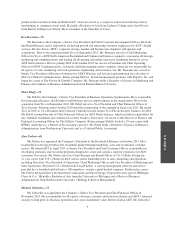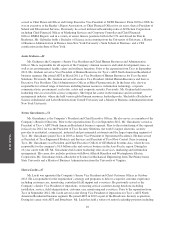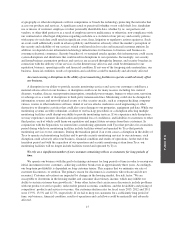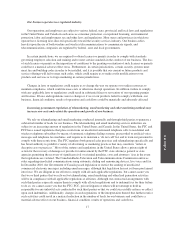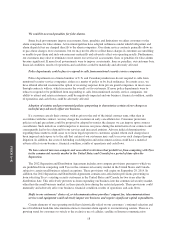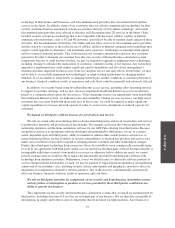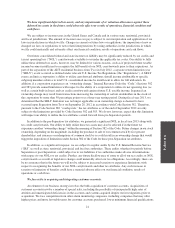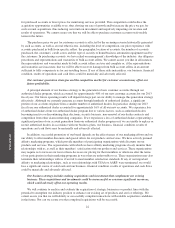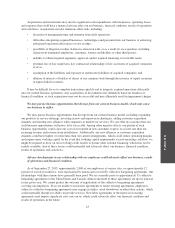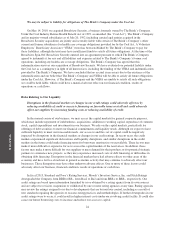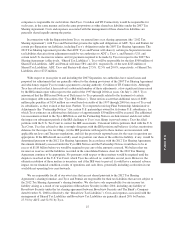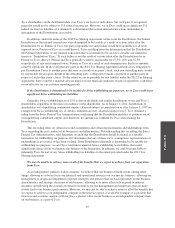ADT 2013 Annual Report Download - page 83
Download and view the complete annual report
Please find page 83 of the 2013 ADT annual report below. You can navigate through the pages in the report by either clicking on the pages listed below, or by using the keyword search tool below to find specific information within the annual report.
FORM 10-K
technology in their homes and businesses, and telecommunication providers may discontinue their land-line
services in the future. In addition, many of our customers who use cellular communication technology for their
security and home/business automation systems use products that rely on 2G cellular technology, and certain
telecommunication providers have advised us that they will discontinue their 2G services in the future. Older
installed security systems use technology that is not compatible with the newer cellular, satellite or Internet
communication technology, such as 3G and 4G networks, and will not be able to transmit alarm signals on these
networks. The discontinuation of land-line, 2G cellular and any other services by telecommunications providers,
and the switch by customers to the exclusive use of cellular, satellite or Internet communication technology may
require system upgrades to alternative, and potentially more expensive, technologies to transmit alarm signals
and for systems to function properly. This could increase our customer attrition rates and slow new customer
generation. In order to maintain our customer base that uses security and home/business automation system
components that are or could become obsolete, we may be required to upgrade or implement new technologies,
including offering to subsidize the replacement of customers’ outdated systems at our expense. Any technology
upgrades or implementations could require significant capital expenditures and also divert management’s
attention and other important resources away from our customer service and sales efforts. In the future, we may
not be able to successfully implement new technologies or adapt existing technologies to changing market
demands. If we are unable to adapt timely to changing technologies, market conditions or customer preferences,
our business, financial condition, results of operations and cash flows could be materially and adversely affected.
In addition, we recently began using broadband Internet access service, including video streaming services,
to support our product offerings, and we may choose to implement broadband Internet access in our intrusion
panels as a communications option for our services. Video streaming services use significantly more bandwidth
than traditional Internet activity. As utilization rates and availability of these services increases, our high-speed
customers may use more bandwidth than in the past. If this occurs, we could be required to make significant
capital expenditures to increase network capacity in order to avoid service disruptions or reduced capacity for
customers.
We depend on third-party software licenses for our products and services.
We rely on certain software technology that we license from third parties and use in our products and services
to perform key functions and provide critical functionality. For example, we license the software platform for our
monitoring operations and the home automation software for our ADT Pulse offering from third parties. Because
our products and services incorporate software developed and maintained by third parties, we are, to a certain
extent, dependent upon such third parties’ ability to maintain or enhance their current products and services, to
ensure that their products are free of defects or security vulnerabilities, to develop new products and services on a
timely and cost-effective basis and to respond to emerging industry standards and other technological changes.
Further, these third-party technology licenses may not always be available to us on commercially reasonable terms
or at all. If our agreements with third-party vendors are not renewed or the third-party software becomes obsolete, is
incompatible with future versions of our products or services or otherwise fails to address our needs, we cannot
provide assurance that we would be able to replace the functionality provided by the third-party software with
technology from alternative providers. Furthermore, even if we obtain licenses to alternative software products or
services that provide the functionality we need, we may be required to replace hardware installed at our monitoring
centers and at our customers’ sites, including security system control panels and peripherals, in order to affect our
integration of or migration to alternative software products. Any of these factors could materially and adversely
affect our business, financial condition, results of operations and cash flows.
We rely on third party providers for components of our security and home/business automation systems
and any failure or interruption in products or services provided by these third parties could harm our
ability to operate our business.
The components for the security and home/business automation systems that we install are manufactured by
third parties, including divisions of Tyco that are no longer part of our business. We are therefore susceptible to
interruptions in supply and to the receipt of components that do not meet our high standards. Any financial or
19


